| Sint Nicolaas | |
|---|---|
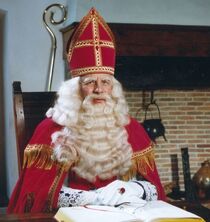
| |
| Also Known As | Goedheiligman, Goedhylickman, Hylickmaker, Sinterklaas |
| Natural Habitat | The Netherlands, Spain |
Modern Dutch Tradition[]
Sinterklaas is a yearly tradition from the Netherlands and part of Belgium. According to a Dutch poll from 2010, it is deemed the number 1 of all festivities in the country.[1] It features a saint known as Sinterklaas; also known as Sint Nicolaas or just Sint. This age-old man visits the Netherlands each year with his many helpers who are known as Zwarte Pieten (translation: Black Petes), to bring gifts to little children. He somewhat looks like a bearded pope.
Appearance[]
A Sinterklaas outfit consists of several layers of clothing: At the very bottom a long purple tabard which is covered by a slightly shorter white alb. A red and gold stola goes around the neck, and a red and gold cope to go over the shoulders. On the head goes a red and golden mitre, sometimes decorated with gemstones. Other than that Sinterklaas wears a gold ring over his white gloves and carries around a golden crozier.[2] Sometimes he also carries a big red book which he uses to keep track of children's behavior. Furthermore, he has a long white beard, and rides a white horse which quite officially goes by the name of Amerigo since 1990[3].
Welcoming Ceremony[]
The actual tradition is kicked off with the welcoming ceremony. That's when a great show is put up where Sinterklaas arrives by boat, accompanied by many of his helpers. This always happens on the first Saturday after November 11th.
Placing Shoes[]
From that moment forward, children may place their shoe each night, oftentimes filling their footwear with a drawing for Sinterklaas or a treat for his horse, and singing traditional songs for Sinterklaas before going to bed. This is the modern approach however. Traditionally children would place their shoe by the hearth just once, on the night of 5 December. They are told that Sinterklaas and Black Pete will enter their house at night (traditionally by chimney), and if they've been good, they'll find a small present or some sort of candy by morning. Back in the day, kids who'd been naughty would receive salt instead of candy. A birch rod wasn't uncommon either. Parents would use this to beat their child into obedience. Sinterklaas and Black Pete have also been known to beat children right in front of their parents. Worst case scenario, children were kidnapped in a jute back and taken to Spain, only to return one day as a black Pete themselves. Of course the saint's methods have become a lot milder since then.
Present Night[]
While the original saint (Nicholas of Myra) died on the 6th of December, oddly, Sinterklaas is celebrated on December 5th, which is Pakjesavond. This is said to be the birthday of Sinterklaas, where the saint goes across the Netherlands, visiting each household to leave a big jute bag filled with presents. Originally, December 5 wasn't known as pakjesavond. It was instead the day for children to place their shoe at the hearth, meaning that December 6th was the original day for them to receive their presents. This was commonly known as pakjesochtend. On this day Sinterklaas leaves the country. His disappearance is sudden and mysterious for most people, but in some parts of the Netherlands a farewell ceremony can be attended.
Secret Sinterklaas[]
Those whom are too old and don't believe in Sinterklaas, oftentimes still celebrate the holiday by playing Secret Sinterklaas. Attenders draw random names from a hat and then buy presents for the person they draw. This is similar to Secret Santa, but with one big difference. Some creative skill is required, as the wrapped presents are oftentimes hidden inside cardboard creations reminiscent of piñatas. The Dutch call this thing a "Surprise" (pronounced "sur-pree-suh"). A surprise often represents an aspect of the recipient's interests, making this a very personal wrapping.
Origins of Saint Nicholas[]
While Sinterklaas is famous for being a goedheiligman, which translates to Good Holy Man, not many people in the Netherlands know the saint for who he truly is: A Goedhylickman or Goed Huwelijk Man, which translates to Good Marriage Man. He's a Christian patron of children and a protector of unmarried women. Original Sinterklaas traditions were very similar to modern Valentinesday. Among other things, he's associated with the protection of orphans, scholars, students, sailors, travelers, merchants, pawn-brokers, bankers, judges, victims of judicial mistakes, captives and the poor. Sometimes even thieves and murderers.
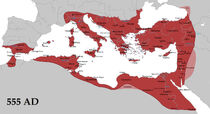
The Byzantine empire in 555 AD.
What people from the Netherlands can generally tell about the history of Sinterklaas, is that saint Nicholas originally came from Turkey. Despite being the most popular tradition in the Netherlands, most Dutch folk live in their own bubble; knowing very little of the actual history, and being somehow blind to the many other traditions it has spawned over the rest of the continent. To be fair though, the history of Saint Nicholas is a confusing one. Little is known about the saint. So little in fact, that he has been denounced from the great pantheon of Roman Saints in 1970.[4]
A German writer by the name of Karl Meisen tried to make sense of it all and published a book in 1931. According to his research, the oldest legends mix up 2 different individuals by the name of Nicholas. Both born in the same Byzantine area (ancient Turkey), they had lived approximately 150 years apart from each other. If that weren't confusing enough, stories of a third Nicholas originated in Italy circa the late 14th century and were later added to the legacy.[5]
Nicholas of Myra[]
Saint Nicholas of Myra (270 - 343) is the original Sinterklaas. Born in Byzantine Patara, he was of wealthy descent and brought up to be a devout Christian. When his parents died at young age, Nicholas devoted his life to the work of God. He was made bishop of Myra at an unusually young age. Concerning himself with the sick and the poor, he gave up his own possessions to help those in need. A man of justice; he loved all children and found himself concerned with maritime and protected unwed women. Many stories were told about the Nicholas of Myra, some of which formed the foundations of modern Sinterklaas. Several of his stories involve exorcism, explaining why he is sometimes portrayed with an enslaved demon. One can safely assume many of the saint's selfless acts went uncredited, as he practiced them anonymously.[6][7][8]
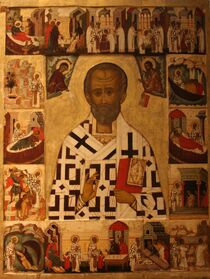
Saint Nicholas of Myra.
Nicholas of Sion[]
Nicholas of Sion (6th century) was born in the Byzantine Pharroa. He grew up to be a monk in Sion, and later on became a bishop in Pinara. Accurate descriptions have been found of his journeys, involving miracles reminiscent of the stories from Myra. Because of these similarities, their legacies must have gotten mixed up during the 9th and 10th centuries.[9][10]
Nicholas of Tolentino[]
Nicholas of Tolentino (1246 - 1305) was an Italian priest. His parents were incapable of conceiving any children until they prayed at the Nicholas of Myra shrine, which is how their son adopted the name. He became a monk at the age of 18, and priest at the age of 25. Legend tells Nicholas helped the poor, protected children and sailors, and was capable of resurrecting the dead. It is said he had visions of purgatory and the devil once hit him with a stick.[11]
The Myra Legends[]
There's well over 20 different stories that involve saint Nicholas of Myra.[12] Some of the better-known stories form the backbone of this Dutch tradition.
The dowry[]
A father of three daughters lamented as they would likely not ever get married. For them to do so, he would have to provide a dowry, which he couldn't. As a result, they would most likely end up as slaves or prostitutes. When bishop Nicholas heard of this, he anonymously left each of them valuables by either tossing it through the window, or dropping it through the chimney. Some say he gifted them loose coins, other times a bag of money. Again others say they were golden balls. Stories vary but they are said to have landed in shoes or stockings and eventually each of the girls got married.
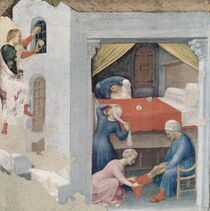
The dowry, as depicted by Gentile da Fabriano (1370 - 1427)
Tamer of storms[]
During his pilgrimage to the holy land, saint Nicholas found himself on a ship. Some say he had visions of a terrible storm and warned the crew for the horrible things to come. Nevertheless, their ship could not escape the ominous change of the weather. In threat of shipwreck, saint Nicholas just calmly prayed and the clouds immediately disappeared, leaving everyone in awe at what had happened. Some versions of the story speak of saint Nicholas reviving a poor sailor who had fallen victim to the relentless waves.
The murders[]
This is one of the later stories and knows many different versions, but it always involves a killer and three victims. Sometimes the killer is a butcher during a great famine, resorted to killing in order to get more food. Other times he is an ill minded innkeeper looking to rob and kill. Saint Nicholas eventually meets the killer, finds out about his awful deeds and revives the victims through prayer. Victims range from being clerks to students, but seeing as saint Nicholas is a patron of the youth, young children are the most popular variant.
History of a Dutch Tradition[]
Sinterklaas has gone through a number of changes in order to become the Dutch tradition it is today. Or rather, changes were upon the Netherlands. The earliest version of Sinterklaas was said to have satanic companions, similar to the many versions of Saint Nicholas over the rest of Europe. This Christian duality symbolized how Saint Nicholas overcame the devil.[13]
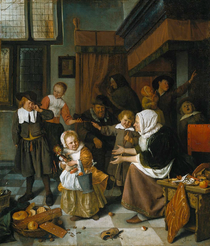
Sinterklaas as celebrated in the 17th century, by Jan Steen (1626 - 1679).
A forgotten tradition[]
Much changed when French king Louis XIV issued the Edict of Fontainebleau in 1685, which stated everyone in France should conform to Roman Christianity. Just then France had become a dangerous place for protestants. Endangered civilians fled the country, sharing their Calvinist mindset with the rest of Europe. Calvinism became very popular in the Netherlands, leading rulers to abolish Christian traditions entirely. Regardless of religion, Sinterklaas was already a well established national holiday at the time, sharing similarities to modern Valentines day. Those who still wanted to celebrate Sinterklaas, did so at home in private. The common folk forgot about the saint's helper over the course of time but it's quite possible he bore similarities to the German Ruprecht.[14] Sinterklaas had become a lone wolf; Both a saint and punisher. It is unclear whether the absence of Roman Catholicism led people to forget about his Byzantine roots and speculate inaccurately about his residence in Spain. [15]
The return of Sinterklaas[]
Inspired by the French revolution of 1789, the Dutch common folk formed a resistance against noble rulers at the end of the 18th century. Former French revolutionists became politicians and formed a puppet state called Batavia, which would help spread the revolution to other parts of Europe. This Batavian revolution helped Dutch patriots in overcoming their oppressor Willem V in 1795 without any bloodshed. French ideologies of human freedom and equality offered a wider acceptance of Catholicism, which in turn meant the return of Sinterklaas.[16]
A new helper[]
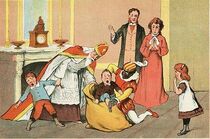
Sinterklaas and his helper were known to kidnap naughty children.
Though Sinterklaas had once again become an accepted tradition at the end of the 18th century, the return of the saint was not so welcoming. Many children had come to know the saint as a stern punisher of naughty children and were afraid of him. While the actual tradition may have been forgotten, there were still rumors of a helper. In an attempt to popularize the saint once more, the helper was brought back, although nobody knew what he actually looked like. The helper's appearance was experimented with a lot. Oftentimes he was portrayed as a white male in a strange getup, but this appearance did not quite catch on. Either way, the helpers were known to be stern punishers. They would carry a bundle of willow twigs which they would use to spank misbehaving children with and there was also a risk of bad children ending up in a jute bag and being brought back to Spain. Sinterklaas has made a public announcement on November 22 1986 however, telling his helpers to be nice to kids from now on.[17]
Introduction of Black Pete[]
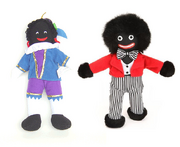
A Black Pete doll next to a Golliwog doll
It is rumored that the black appearance of the helper was first introduced at the end of the 18th century. A source from 1884 speaks of an 1828 memory where saint Nicholas was accompanied by a black man with frizzy hair.[18] It was school teacher Jan Schenkman however who further popularized Black Pete's image with his book of rhymes for children entitled "Sint Nikolaas en zijn knecht" from 1850. This book also introduced the saint's fictional backstory.
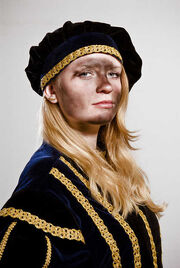
A "roetveegpiet" is a partially soot-stained helper of Sinterklaas.
Since the release of Jan Schenkman's book, Sinterklaas has been a festive yet controversial tradition. It can be surmised that the growing popularity of Gollywog dolls since the release of Florence Kate Upton's "The Adventures of Two Dutch Dolls" in 1895 and other works of fiction like "The Story of Little Black Sambo" by Helen Bannerman from 1899 may have further contributed to the behavior and appearance of the new helpers.[19][20] Whenever Zwarte Piet makes his appearance, it's commonplace for caucasians to dress up in matching knickerbockers and jacket with feathered hat and gloves, a black frizzy wig, maillot, big earrings, red lipstick and black face paint. Many view this depiction of Zwarte Piet as a racist caricature, while others justify the appearance by saying Sinterklaas' helper is always getting his face dirty with soot as he spends a lot of time climbing through people's chimneys. From the 1960's onwards, there's been many protests that didn't catch on with the general public. In 2013 however, discussions about Zwarte Piet's appearance became a national talking point. Many black rights groups advocate for the abolishment of the helper to this day. Over the years the public has tried to come up with new varieties of helpers, the most promising version of which seems to be the partially soot-stained Piet.
The saint from Spain[]
With the original saint born in what is now modern Turkey, one can only speculate why the Dutch tell of a saint from Spain.
A popular assumption is that it all could have started when two decades prior to the Batavian revolution at the end of the 18th century, the Dutch were to celebrate Sinterklaas in secrecy. With a lack of Roman catholic guidance, the common folk quite possibly forgot about the saint's actual heritage. Seeing as the old man was known to come from a warm climate and brought oranges along with him, that may have clued the Dutch in on Spain, which was a country the Netherlands were well familiar with.
Another completely different theory goes way back in time, when only the Byzantine area acknowledged the saint's existence. Rumors of Seljuks overtaking the city of Myra led to an Italian expedition in order to steal the remains of saint Nicholas. From his crypt, the body was taken to the city of Bari where he safely remains to this day. A church was built in his honor and word of his deeds spread across Europe, turning Bari into a pilgrim site. Italy eventually fell into Spanish hands, and with Spanish emperors on Dutch soil, civilians were led to assume his Spanish descent.[21]
Germanic Influences[]
German writer Karl Meisen linked the incoherent traditions of Saint Nicholas to a lack of church control layered with heathen influences in his book "Nikolauskult und Nikolausbrauch im Abendlande" from 1931. He made a comparison to the Germanic god Wodan. According to him, the festivities are a Christianized version of Yule. There is no proof that any of this is actually true, however.
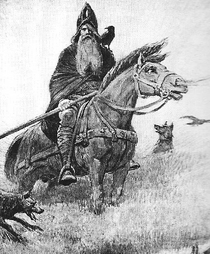
Sinterklaas bears many similarities to Wodan.
Some countries depict the saint riding a donkey but the legends don't make mention of him riding any animals. Still Sinterklaas rides his horse over the rooftops as his helping Black Petes deliver presents to the children via chimney. Some connect this to Wodan, as he rode the eight-legged Sleipnir through the sky with his army of the dead. Similarly, Black Petes resemble Wodan's black spying ravens. And while children leave food for Sinterklaas' horse, the Germanic folk sacrificed food to their gods by stuffing it in socks and shoes by the hearth. Wodan even had a helper named Oel who rated the offers by peering through the chimney. Another helper was Nörwi, a rhyming giant known to be the "black father of the night". He carried around a birch staff, similar to the tools carried by Black Petes used for disciplining children. Instead of a golden crozier, Wodan carried with him a lance named Gungnir. He wore a mantle and a hat similar to the mitre. While the Byzantian church has always depicted Saint Nicholas with a short beard, Sinterklaas has a full beard that matches Wodan's.[22][23][24][25][26]
Symbolism[]
Hylickmakers[]
Hylickmakers or Vrijers were little figures imprinted on convectionaries, such as speculaas and the taaitaai. While these confectionaries were not exclusively associated with the Sinterklaas tradition, the word "hylickmaker" (proper Dutch: huwelijkmaker) meant "marriage maker" and refers to one of the stories involving saint Nicholas of Myra, where he saves 3 daughters from prostitution by providing them a dowry. Hylickmakers were traditionally used for confessions.[27] It is entirely possible Sinterklaas is not a "Goedheiligman" (translation: Good holy man), but a "Goedhylickman": A good marriage man.
Sweet Letters[]
Most commonly, letters appear in chocolate form and a Dutch pastry known as banket. How the letter tradition started isn't entirely certain. Expert on 19th century children books Frits Booy has 2 theories on the matter, which he enclosed in his book "Sint Nicolaas van A tot Z". He says it is possible the tradition was derived from an old school system. Medieval monastery schools used edible letters made of bread to teach children how to write. Students were then allowed to eat them as a reward. A different theory tells of a 19th century custom, where presents were covered by a sheet which had the first initial of the addressed child attached to it.[28]
Chocolate Coins[]
Coin-shaped pieces of chocolate wrapped in gold foil are sold in little nets around the time of Sinterklaas. It is unclear whether the chocolate candy coin traditionally originated from the Christian Sinterklaas or Jewish Hanukkah. Either way the gold coins refer to a story where saint Nicholas of Myra saves 3 daughters from moving into prostitution by providing them money for an acceptable dowry.[29]
Kruidnoten and Pepernoten[]

The difference between pepernoten (left) and kruidnoten (right).
Kruidnoten and pepernoten (translation: herbnuts and peppernuts, respectively) are small cookie-like confectionaries. While both of them look and taste very different, many Dutch people will wrongly refer to kruidnoten as pepernoten. Modern kruidnoten have a flat bottom but are otherwise round in shape and are made from the same dough as speculaas cookies, while pepernoten are cube-shaped and made from the same dough as taaitaai. Both of these are commonly thrown or given by black Pete as a treat for little children. The act of scattering food was often used as a blessing of fertility. This links back to saint Nicholas of Myra, who was a Christian patron for unmarried women.
Oranges and Mandarins[]
Oranges and mandarins represent golden balls. Nicholas of Myra is often depicted with these balls, which in turn symbolize the valuables he gifted to three young women in distress. Their father could not afford a dowry, jeopardizing the future of his daughters.[30]
Marzipan[]
Invented in Italy, the Italians have always affiliated marzipan with love. Its symbolic background is very similar to the hylickmakers for that reason: Traditionally, boys bought it for girls as a confession of their love. This too is linked to the story of Myra where saint Nicholas made an effort to protect 3 young women by leaving them enough money for a dowry. By enabling these women to marry, the saint had saved these young women from going into prostitution.[31]
Outfit[]
The crosses on Sinterklaas his outfit obviously point to Christian roots, but most of his appearance can be thanked to Jan Schenkman, who has popularized the saint's modern look in 1850. Mitres did not exist prior to the year 1000, and the saint did not dress himself in red garb either. All of these are ostentations, meant to symbolise his unmeasurable riches. Apart from the mitre, his crozier is a very common bishop attribute, meant to represent him as shephard of the people.
Steamboat[]
The origin of the steamboat was introduced by Jan Schenkman in 1850. In the mid 19th century steamboats were considered to be quite modern, indicating to young children how wealthy Sinterklaas must be. Nicholas of Myra was known as a protector of sailors, possibly explaining why modern traditions have him travel by boat. Another reason could be be linked to an old tradition from the Italian town of Bari. To this day, Bari celebrates an innitiative undertaken in 1087, when a group of Italian sailors took a boat to Myra in order to steal the remains of saint Nicholas, thus bringing saint Nicholas to Europe by boat. The remains of the saint are still kept in Bari to this day.[32][33][34]
Candy[]

Candy and confectionaries[35] affiliated with the Sinterklaas festivities are generally not sold as much during other times of the year. These include:
- Marzipan Figures
- Fondant Figures
- Pepernoten
- Kruidnoten
- Taaitaai
- Mandarins
- Oranges
- Duivekater
- Chocolate Letters
- Chocolate Coins
- Banket Letters
- Speculaas
- Borstplaat
Songs[]
The Sinterklaas festivities involve a lot of singing. Many of the original songs have however been modified because of questionable content. Some original titles include:
- Zie Ginds Komt De Stoomboot
- De Zak Van Sinterklaas
- Hoort, Wie Klopt Daar
- Sinterklaas Goed Heilig Man
- Sinterklaasje Kom Maar Binnen Met Je Knecht
- Hop, Hop, Hop, We Zitten Nu Rechtop
- Strooien, Strooien, Strooien
- Sinterklaas, Zegt Moe
- Wie Komt Er Alle Jaren
- Jongens, Heb Je Het Al Vernomen
- Zachtjes Gaan De Paardevoetjes
- Hoor De Wind Waait Door De Bomen
- Hoor Wie Klopt Daar
- Hij Komt, Hij Komt
- Zie De Maan Schijnt Door De Bomen
- Sinterklaas Kapoentje
- Sinterklaasje Bonne Bonne Bonne
- O, Kom Er Eens Kijken
- Sinterklaas Die Goede Heer
- Op De Hoge, Hoge Daken
- Sinterklaas Is Jarig
- Dag Sinterklaasje
References[]
- ↑ http://www.meertens.knaw.nl/cms/nl/nieuws-agenda/nieuws-overzicht/202-nieuws-2013/144371-faq-zwarte-piet
- ↑ http://kunst-en-cultuur.infonu.nl/geschiedenis/63834-de-kleding-van-sinterklaas-de-mantel-de-mijter-en-de-staf.html
- ↑ https://nl.wikipedia.org/wiki/Amerigo
- ↑ http://www.sint-en-santa.eu/eng01nhistory.php
- ↑ Karl Meisen: Nikolauskult Und Nikolausbrauch Im Abendlande
- ↑ http://www.stnicholascenter.org/pages/who-is-st-nicholas
- ↑ https://en.wikipedia.org/wiki/Saint_Nicholas
- ↑ http://www.stnicholascenter.org/pages/traditional-stories/
- ↑ http://www.stnicholascenter.org/pages/others/#Sion
- ↑ http://www.saintnicholasway.com/en/saint-nicholas/
- ↑ https://en.wikipedia.org/wiki/Nicholas_of_Tolentino
- ↑ http://www.stnicholascenter.org/pages/traditional-stories/
- ↑ http://a-six-demon-bag.blogspot.nl/2010/12/santas-evil-helpers.html
- ↑ https://nl.wikipedia.org/wiki/Knecht_Ruprecht
- ↑ http://www.trouw.nl/tr/nl/4324/Nieuws/article/detail/1198070/2008/12/06/Calvinisten-ruzieden-over-schoen-zetten.dhtml
- ↑ http://www.kennislink.nl/publicaties/de-duistere-looks-van-zwarte-piet
- ↑ https://www.dbnl.org/tekst/hovi002cult01_01/hovi002cult01_01_0011.php
- ↑ https://www.meertens.knaw.nl/cms/nl/nieuws-agenda/nieuwsbrief/uitgelicht/144655-zwarte-piet-als-kikker-een-heel-andere-piet-uit-1886
- ↑ https://www.ferris.edu/news/jimcrow/golliwog/
- ↑ https://web.archive.org/web/20110501082810/http://www.ferris.edu/news/jimcrow/picaninny/
- ↑ http://kunst-en-cultuur.infonu.nl/feestdagen/62328-waarom-de-sint-uit-spanje-komt-en-santa-claus-uit-nederland.html
- ↑ http://www.jefdejager.nl/sint.php
- ↑ http://kunst-en-cultuur.infonu.nl/feestdagen/85940-is-sinterklaas-de-germaanse-god-wodan.html
- ↑ http://poppiesandicecream.blogspot.nl/2011/12/sinterklaas-is-coming-tonight.html
- ↑ https://en.wikipedia.org/wiki/Narfi
- ↑ http://a-six-demon-bag.blogspot.nl/2010/12/santas-evil-helpers.html
- ↑ http://www.bakkerijmuseum.nl/kalwiblo/index.php?t=3&h=18&s=204
- ↑ http://www.chocoladeletter.net/
- ↑ http://www.ownways.com/chocolate/Chocolate_Coin.html
- ↑ http://www.stnicholascenter.org/pages/symbols/
- ↑ http://www.bakkerijmuseum.nl/kalwiblo/index.php?t=4&h=43&s=97
- ↑ http://www.orangesmile.com/travelguide/bari/traditions--111255.htm
- ↑ http://www.stnicholascenter.org/pages/saint-in-bari/
- ↑ https://nl.wikipedia.org/wiki/Overleg:Sinterklaas#Stoomboot_uit_Spanje
- ↑ http://sinterklaasmijnhobby.jouwweb.nl/sinterklaas-weetjes/lekkernijen